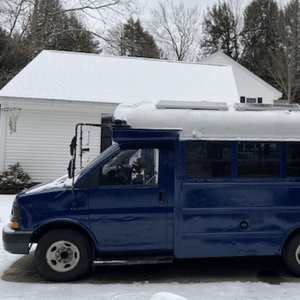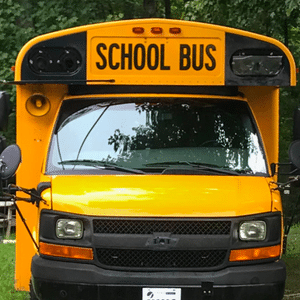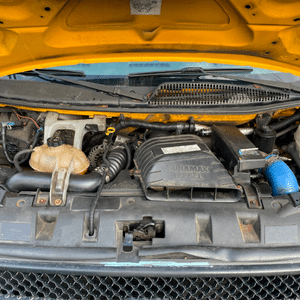How To Remove A 4.3 L Engine
The Chevy 4.3L Vortec (4300) is a family of half-dozen-cylinder pocket-size-block gasoline engines introduced by General Motors in 1985 and phasing out in 2022. The Chevy 4.3L Vortec is the longest living and most successful of the Vortec engine family. While the general make-up of the Chevy 4.3L Vortec engine remained the same over its 40-yr product history, there were several upgrades and changes to components and features over the years.
This 4.3L Vortec engine is a part of our Engine Guide series to help with buying a school jitney for sale.
This article will swoop further into the 4.3L Vortec engine often plant in Chevy and GMC short buses including:
- Engine Overview
- Engine Specs
- Towing Capacity
- Life Expectancy
- Maintenance Requirements
- Typically paired transmissions
- Common engine problems
- Engine comparisons to the 6.0L Vortec, v.7L Vortec and GM 6.6L Duramax
Chevy 4.3L Vortec Engine Overview

In that location are two distinct engine models, which transitioned in 2022 for modernization. Before model year engines dating before 2022 were featured in sports cars and trucks, and they provided vehicles with 155 horsepower and 230 pound-feet torque ratings. The 2nd group of Chevy 4.3L Vortec engines launched in 2022 came with more power and better fuel economic system. They were featured in Chevrolet and GMC total-size trucks and vans.
The Vortec technology name came from the word "vortex," because Full general Motors designed the engine to create a pressurized swirl, similar a mini-tornado, within the combustion chamber to efficiently blend gas and air together. The vortex enabled the engine to produce more ability while still gaining a marginal amount of fuel efficiency.
There are some notable variants of the Chevy 4.3L Vortec engine line. The outset variant, known as the LB1, lasted only one production yr. It was featured on Chevrolet and GMC full-size pickup trucks and vans. Yet, it was modified with a different injection system for employ in Full general Motors cars, such as the Chevrolet Caprice, Chevrolet El Camino, and Pontiac M Prix. The second variant, known as LB4, featured several changes to increase ability and was expanded to power Chevrolet Silverado and GMC Sierra trucks.
In the mid-1990s, the Chevy 4.3L Vortec engine phased out its machine lineup, and it continued product for but pickups, vans, and sport utility vehicles. The engine family unit had expanded to include a minor block V8 pattern to eternalize efficiency rather than boost power.
In the early on 2000s, the Chevy 4.3L Vortec engine added some other V6 blueprint known as the EcoTec3 (or LU3). It was prominently featured in the all-new 2022 Chevrolet Silverado and GMC Sierra full-size trucks, as well equally Chevrolet Express and GMC Savana vans. A new multipoint fuel injection organisation was added to heave performance to 285 horsepower and 305 pound-feet torque ratings. However, gas consumption remained high at 16 miles per gallon.
General Motors planned to retire the Chevy 4.3L Vortec when launching to 2022 Chevrolet Silverado 1500 and GMC Sierra 1500.
iv.three Vortec Engine Specs
| Engine | Production Years | Horsepower | Torque |
| Chevy 4.3L Vortec engine | 1985 to 2022 2014 to 2022 | Low: 155 hp @ 4600 RPM Loftier: 285 hp @ 5300 RPM | 230 lb-ft @ 2800RPM 305 lb-ft @ 3900 RPM |
iv.iii Vortec Transmissions
All Chevy 4.3L Vortec engines were paired with a five-speed manual transmission made by General Motors. Variants made afterwards 2022 were made with a General Motors 6-speed automatic with transmission shifting mode.
Towing with a iv.3L Vortec Engine
The standard Chevy iv.3L Vortec had a maximum towing capacity of seven,900 pounds.
Chevy 4.3L Vortec Engine Life Expectancy
Considered a reliable motor, the Chevy 4.3L Vortec was the longest-lasting production in the Vortec engine series. Mechanics report these engines are capable of lasting up to 300,000 miles with standard engine maintenance schedules and melody-ups. Despite first being introduced in the mid-1980s, in that location are several of these engines however in the aftermarket today.
Chevy four.3L Vortec Engine Maintenance Requirements
The Chevy 4.3L Vortec line is a gasoline-powered engine. Longevity is possible through proper maintenance of regular oil changes, engine coolant flush, fuel filter replacements, and transmission fluid and filter replacements. Actress care is needed for engines that operate under severe or heavy-duty conditions, including excessive idling, dusty environments, and frequent hauling.
Chevy 4.3L Vortec Oil Capacity: 6 quarts
| Engine variations | Normal weather condition |
| Chevy 4.3L Vortec | Engine oil & air filter: 7,500 miles/12 months Fuel filter: 25,000 miles Engine coolant: 150,000 miles Transmission fluid & filter: 22,500 miles |
Common iv.3L Vortec Engine Problems
Mechanics report the Chevy 4.3L Vortec is a very undecayed engine with regular maintenance. However, the engine is known to have some bug, especially when reaching the 300,000-mile mark.
- Idle control valve and throttle position sensor failure – The idle control valve (ICV) sits on the throttle body and is responsible for adjusting the amount of air that enters the engine at idle. At idle, the valve blocks a small corporeality of air from inbound the engine, keeping idle RPM'southward low. When big volumes of air that pass through it, the valve tin can get clogged and function poorly, creating idle issues. The ICV and throttle position sensors (TPS) are prone to failure, which tin event in poor idling, engine stalling, bad dispatch, and other low rpm running problems.
- Intake Manifold gasket failure – Afterwards variants of the Chevy 4.3L Vortec engines (LB4 and L35) are prone to engine leaks, overheating and stalling due to a faulty intake gasket that sits between the intake manifold and the cylinder caput. Over fourth dimension, the pressure and temperature exerted on the gasket tin can cause it to crack, leak engine coolant and lose engine vacuum. The most noticeable symptom of this will be a depression coolant light, engine overheating, or coolant puddles underneath the vehicle. Intake gaskets are known to start leaking equally frequently as every 50,000 miles.
- Benefactor failure and benefactor cap – The Vortec distributor is responsible for providing the ignition coils with the electricity required to power the spark plugs and create combustion. The cap is prone to warping from the heat, which results in the cap rubbing against the benefactor rotor button. This causes the rotor bushing to vesture out and the benefactor begins to no longer be able to turn. Symptoms include engine misfires, slow/no starts, poor idling or acceleration. The simplest option here to fix this problem is upgrading to a benefactor that has an aluminum housing on it.
- Key port injection leaks – Some variant engines from the mid-1990s to early on-2000s had a key port injection setup, known as the "spider." In the L35 and LF6 variant engines, the spider injectors are known to leak at the pressure level regulator. Exterior of leaking fuel onto the exterior of the engine itself, it tin crusade backlog fuel to get sucked into the engine. This tin issue in engine misfires. Some of the unburned fuel can become into the cylinder and so lead to premature combustion due to estrus, creating a misfire. Symptoms include misfire engine codes, long starting, hard cranking, poor idle and running at depression rpms.
- Engine knock – Variant engines made from 1996 to 2002 (L35 and LF6) take engine knock problems that occur when the fuel burns unevenly and out of sync with the engine cycles. Engine knock tin can exist caused by many factors, such as low-course fuel, bad spark plugs or carbon build-upwards. Engine knock is bad for your engines internals and can crusade serious damage to the pistons and to the cylinder walls. Mechanics have fixed the result by replacing the pistons in the engine.
- Excess oil consumption – Some engines made from 2004 to 2009 (LU3) accept been known to eat excessive amounts of oil. The excessive oil consumption is likely to be acquired by an Agile Fuel Management (AFM) system added to increment fuel economic system. The AFM organization works by turning off sure cylinders to better gas mileage. Mechanics written report that excessive oil fire likely won't harm the engine, if oil is consistently added.
Chevy iv.3L Vortec vs. Chevy half dozen.0L Vortec

Both the Chevy four.3L Vortec and Chevy vi.0L Vortec engines were engineered to produce more ability, torque, and engine response while improving overall gasoline fuel economy. They were produced during the same time in the 2000s inside the engine'southward twoscore-year production life.
The Chevy 6.0L Vortec is part of General Motors' small-block V8 gasoline engine line for Chevrolet and GMC heavy-duty trucks, sports utility vehicles, and vans. Beginning in 1999, Chevy 6.0L Vortec engines powered Chevrolet Express vans, Chevrolet Silverado heavy-duty trucks (2500 and 3500), Chevrolet Suburban (2500, 3500), GMC Savana (2500, 3500 and 4500), GMC Sierra heavy-duty trucks (2500 and 3500) and GMC Yukon 40.
General Motors produced ix variants of the Chevy 6.0L Vortec engine over two decades. All of the engine variants have the same basic engine components, simply new technologies were added over fourth dimension to increase both performance and fuel economy. General Motors included several alternative fuel variants in its line of Chevy 6.0L Vortec engines. The LY6 engine variant had a hybrid V8 version available from 2008 to 2022, which provided trucks with a little better fuel economic system and cleaner emissions. The L77 variant, produced from 2010 to 2022, had an ethanol version. The L96 variant included a flex-fuel version, besides as a modified compressed natural gas (CNG) version. The LFA and LZ1 variants were used in GM's hybrid trucks and sport utility vehicles. In 2022, the Chevy 6.0L Vortec engine series was replaced by the Chevy 6.2L Vortec.
The Chevy iv.3L Vortec is a family of half-dozen-cylinder small-scale-cake gasoline engines introduced by Full general Motors in 1985. There are two distinct engine models, which transitioned in 2022. They were featured in Chevrolet and GMC full-size trucks and vans. In earlier year models dating before 2022, the engine was featured in sports cars. The second variant, known as LB4, featured several changes to increase power and was expanded to ability Chevrolet Silverado and GMC Sierra trucks. General Motors planned to retire the Chevy four.3L Vortec when launching to 2022 Chevrolet Silverado 1500 and GMC Sierra 1500.
| Feature comparison | Chevy 4.3L Vortec engine | Chevy half-dozen.0L Vortec engine |
| Product years | 1985 to 2022 Chevrolet Express | 1999 to 2022 Chevrolet Express vans |
| Horsepower | Low: 155 hp @ 4600 RPM Loftier: 285 hp @ 5300 RPM | Low: 300 hp @ 4400 RPM High: 362 hp @ 5400 RPM |
| Torque | 260 lb-ft @ 2800RPM 305 lb-ft @ 3900 RPM | Depression: 360 lb-ft @ 4000 RPM High: 380 lb-ft @ 4400 RPM |
Chevy iv.3L Vortec vs. Chevy 5.7L Vortec

Both the Chevy 4.3L Vortec (V6) and Chevy 5.7L Vortec (V8) engines were engineered to produce more than power, torque, and engine response while improving overall gasoline fuel economy. They were produced during the same fourth dimension in the mid-1990s to early-2000s within the engine's xl-twelvemonth production life.
The Chevy v.7 Vortec engines were small block V8 gasoline engines that could be powered with alternative fuels, such equally ethanol, liquid propane gas (LPG), and compressed natural gas (CNG). They were produced from 1996 to 2002 for Chevrolet Limited, Chevrolet Suburban, Chevrolet Tahoe, Chevrolet/GMC full-size trucks, and Cadillac Escalade.
The v.7L Vortec engine had an overhead valve configuration with ii valves per cylinder and a 4-commodities intake manifold. The Vortec engine had a iv-inch bore (also known as cylinder diameter) and a 3.48-inch stroke, or the length a piston moves between top and lesser. This added more horsepower and operation to the engine. The engine's intake valve and combustion bedroom design too are much dissimilar than previous truck engine models. The Vortec combustion chamber is a kidney-shaped blueprint that promotes meliorate performance.
The Chevy 5.7L Vortec engine was replaced in 2002 by the Chevy 5.3L (5300) engine in 2002. Nonetheless, the Chevy 5.7L Vortec engine is well supported in the aftermarket with replacement components and rebuild kits. There are as well aftermarket kits for owners who want to convert their v.7L Vortec gasoline engines to LPG or CNG.
The Chevy 4.3L Vortec is a family unit of six-cylinder small-cake gasoline engines introduced by General Motors in 1985. At that place are 2 singled-out engine models, which transitioned in 2022. They were featured in Chevrolet and GMC full-size trucks and vans. In earlier twelvemonth models dating earlier 2022, the engine was featured in sports cars.
General Motors planned to retire the Chevy four.3L Vortec when launching to 2022 Chevrolet Silverado 1500 and GMC Sierra 1500.
| Feature comparison | Chevy four.3L Vortec engine | Chevy 5.7L Vortec engine |
| Product years | 1985 to 2022 Chevrolet Limited | 1996 to 2002 Chevrolet Express |
| Horsepower | Depression: 155 hp @ 4600 RPM Loftier: 285 hp @ 5300 RPM | 225 HP @ 4600 RPM |
| Torque | 260 lb-ft @ 2800RPM 305 lb-ft @ 3900 RPM | 330 lb-ft @ 2800 RPM |
Chevy four.3L Vortec vs. GM half-dozen.6L Duramax

While the Chevy iv.3L Vortec and GM vi.6L Duramax engines have endured long production histories, they are very dissimilar engines. The Chevy 4.3L Vortec (4300) was a family of six-cylinder small-cake gasoline engines introduced past Full general Motors in 1985 and phasing out in 2022. Even as it evolved with unlike power components, it is the longest living and most successful of the Vortec engine family.
The GM half-dozen.6L Duramax engine ran on diesel, and engineers had to keep amending the diesel fuel engine design to comply with increased emissions regulations effectually the earth. The 6.6L Duramax diesel engine variants evolved with unlike components needed to run into global mandates for reducing emissions while maintaining and even increasing horsepower and torque over time.
General Motors and Isuzu formed a joint venture, called DMAX, to produce a family of 6.6L Duramax diesel V8 engines for Chevrolet and GMC trucks, beginning in the 2001 model yr. Over the past two decades, the joint venture has produced 6 variants of the Duramax diesel fuel engine. Since the first model year, the engines take become popular options for General Motors pick-upward trucks, vans, and medium-duty trucks. It is notwithstanding in production for the 2022 model year.
When it comes to a power comparison, the GM half dozen.6L Duramax diesel engine pulls way ahead of the Chevy 4.3L Vortec gasoline engine. With more than horsepower and torque, the six.6L Duramax is considered more than durable for heavy towing. The best tow chapters comes with the vi.6L L5P Duramax diesel fuel engine, which gives Chevrolet and GMC Hard disk trucks (2017-2019 model years) a maximum tow chapters of 23,300 pounds. In 2022, tow capacity increased to 36,000 pounds. By comparison, the standard Chevy 4.3L Vortec had a maximum towing capacity of vii,900 pounds.
Mechanics report that the best 6.6L Duramax diesel engine was the initial LBZ model, although other models are relatively reliable and durable. Mechanics report the almost problematic models were the vi.6L LLY and LML diesel engines.
Considered a reliable motor, the Chevy four.3L Vortec is the longest-lasting engine in the production of the engine series. Mechanics report these engines are capable of lasting up to 300,000 miles with standard engine maintenance schedules and melody-ups. Despite first being introduced in the mid-1980s, there are several of these engines still in the aftermarket today.
| Feature comparing | Chevy 4.3L Vortec engine | GM 6.6L Duramax diesel engine |
| Product years | 1985 to 2022 Chevrolet Express | 2001 to 2004 6.6L LB7 Duramax 2004 to 2005 6.6L LLY Duramax 2006 to 2007 6.6L LBZ Duramax 2007 to 2022 half-dozen.6L LMM Duramax 2011 to 2022 6.6L LML Duramax 2017 to nowadays vi.6L L5P Duramax Chevrolet Express GMC Savana Chevrolet Silverado HD Chevrolet Kodiak GMC Sierra HD GMC Topkick Hummer H1 Blastoff |
| Horsepower | Low: 155 hp @ 4600 RPM High: 285 hp @ 5300 RPM | Low: 300 hp @ 3100 RPM Loftier: 445 hp @ 2800 RPM |
| Torque | 260 lb-ft @ 2800RPM 305 lb-ft @ 3900 RPM | Low: 520 lb-ft @ 1800 RPM High: 910 lb-ft @ 1600 RPM |
Source: https://www.skoolielivin.com/chevy-4-3l-vortec-engine/

0 Response to "How To Remove A 4.3 L Engine"
Post a Comment